
Practical Significance While statistical significance relates to null hypothesis testing practical significance refers to the magnitude of the effect. This can work two ways.
Practical Significance versus Statistical Significance.
Practical significance vs statistical significance. Practical Significance Practical Significance Practical significance is not the same as statistical significance. Recall a general problem with traditional statistics is that if you take large enough samples almost any difference or any correlation will be significant. Due to this problem many editors and publishers are requiring.
Practical Significance While statistical significance relates to null hypothesis testing practical significance refers to the magnitude of the effect. Null hypothesis testing cannot tell you whether the effect is large enough to be important in your field of study or in life itself. While statistical significance shows that an effect exists in a study practical significance shows that the effect is large enough to be meaningful in the real world.
Statistical significance is denoted by p -values whereas practical significance is represented by. The differences between any sample means will be significant if the sample is large enough. However when conducting real-world research statistical significance does not always equate to practical significance or vice versa.
You need to ask the question Can you use the statistically significant or insignificant results in a practical. Practical Significance versus Statistical Significance. When hypothesis-testing tools are used we are working with statistical significance.
Statistical significance is based upon the quality and amount of the data. Process significance involves whether the observed statistical difference is meaningful to the process. This can work two ways.
We have all heard of or applied the above concepts sometime in our livesBut seldom have we realised that the concept of statistical significance can be misleading at times. We have to weigh it. Statistical significance refers to how an unusual event is unlikely to actually appear in a real world application such as every entry in a sample of size 50 having the same value.
Practical significance refers to how an unusual event is. Explain the difference between statistical significance and practical significance. The purpose of this paper is to examine the differences between statistical and practical significance including strengths and criticisms of both methods as well as provide information surrounding the application of various effect sizes and confidence.
Statistical significance is concerned with whether a research result is due to chance or sampling variability. Practical significance is concerned with whether the result is useful in the real world. Results are said to be statistically significant when the difference between the hypothesized population parameter and observed sample statistic is large enough to conclude that it is unlikely to have occurred by chance.
Practical significance refers to the magnitude of the difference which is known as the effect size. Results are practically significant when the difference is large enough to be meaningful in real. Choose the correct answer below.
Statistical significance means that the hypothesis test being performed is useful for building theoretical foundations for other statistical work. Practical significance means that the particular application of the hypothesis test is of. 1 The difference at hand is that statistical significance is a contrived notion that mathematicians have proposed for their models while practical significance is the.
This is where practical significance comes into play. Statistical significance allows one to try and interpret a difference whereas practical significance determines whether. Statistical significance depends upon the sample size practical significance depends upon external factors like cost time objective etc.
Statistical significance does not guarantee practical.